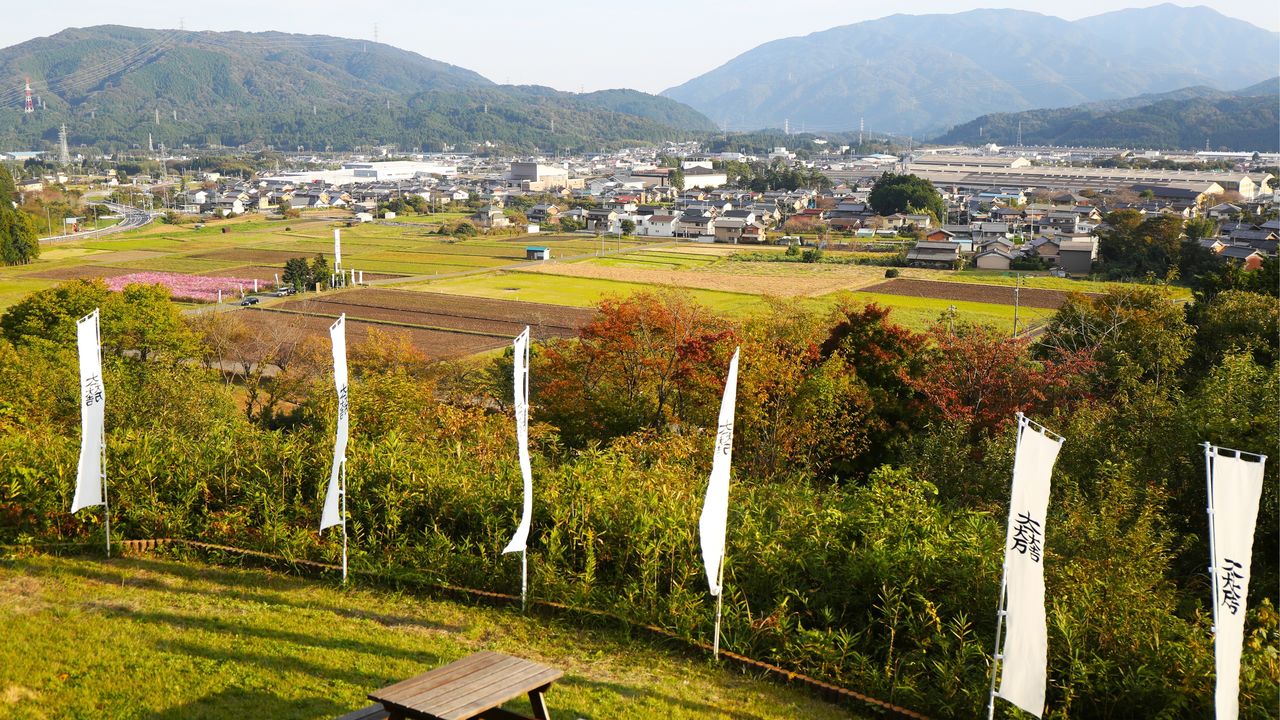
Ieyasu’s Ambition: The Road to Sekigahara
History- English
- 日本語
- 简体字
- 繁體字
- Français
- Español
- العربية
- Русский
Hideyoshi’s Will
On April 20, 1598, Japan’s ruler Toyotomi Hideyoshi held a cherry blossom party at the Kyoto temple Daigoji. He invited more than 1,300 women to this spectacular event, including his principal wife Yoshiko and concubine Yodo-dono, and the wives of the country’s daimyō.
However, from this point onward, Hideyoshi went into physical decline. While it is impossible to say for sure, there has been speculation that he was in the late stages of stomach cancer. He set up a system in which his close allies shared administrative duties as the Five Commissioners, which included Ishida Mitsunari and Asano Nagamasa, while powerful daimyō discussed and made decisions on important matters as the Five Great Elders: Tokugawa Ieyasu, Maeda Toshiie, Mōri Terumoto, Uesugi Kagekatsu, and Ukita Hideie. (In recent years, a theory has emerged that this double system was not quite so clear-cut).
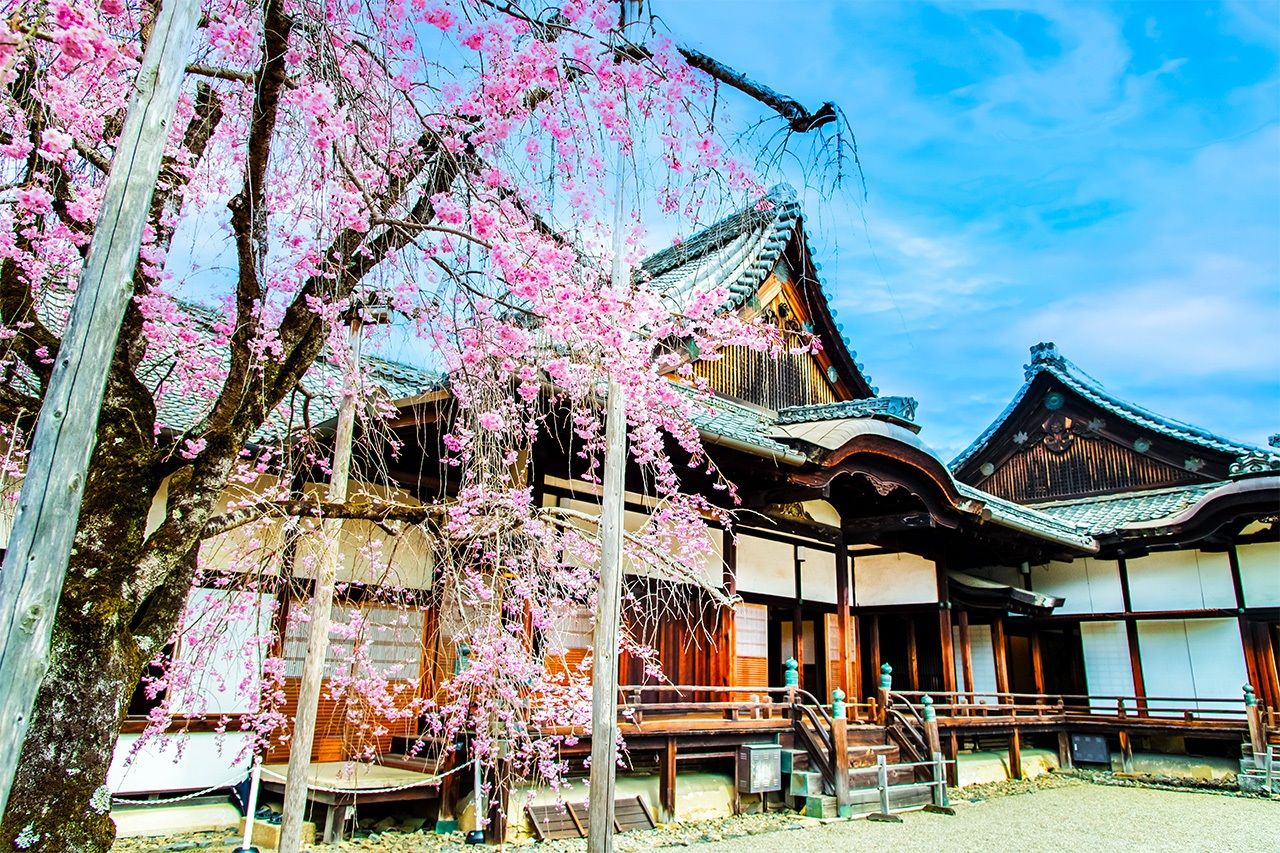
Daigoji, famous as the site of Hideyoshi’s cherry blossom party, is inscribed on the UNESCO World Heritage list as part of the Historic Monuments of Ancient Kyoto. The photograph shows Sanbōin at Daigoji with cherry blossoms in full bloom. (© Pixta)
Two months after the party Hideyoshi, who had collapsed following a ceremony, gave his 11-point will to the Five Commissioners and Five Great Elders, and collected written oaths from them all.
Although the will was for the 10 men, much of its content was directed at Ieyasu and Toshiie, indicating their relative power. It mentioned plans for a marriage between Hideyoshi’s young son Hideyori (born in 1593) and Ieyasu’s granddaughter, calling on Ieyasu to protect Hideyori and manage government affairs from Fushimi Castle after Hideyoshi’s death. Hideyoshi also asked Toshiie to be his son’s tutor. The will called on the elders to follow the law and cut down any of their number who did not. Ieyasu and Toshiie were to be consulted for judgement on any necessary matter.
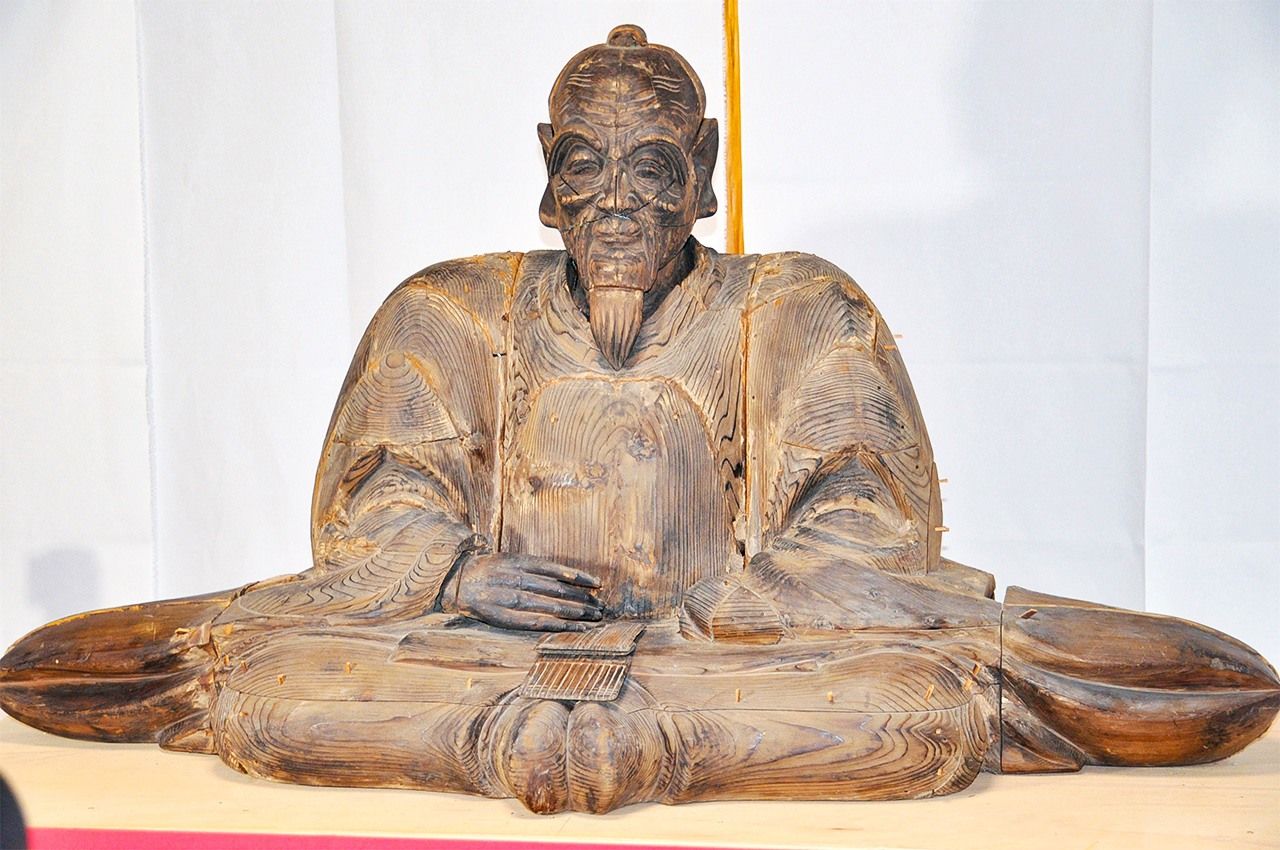
A wooden statue thought to be of Toyotomi Hideyoshi discovered at Ōmiya Shrine in Osaka in May 2020. The statue, dating back to the Edo period (1603–1868), is life-size and therefore the biggest of Hideyoshi in Japan. (© Jiji)
As he sensed the end was near, Hideyoshi distributed goods and money among the daimyō and court nobles, and had them again pledge loyalty to Hideyori. On September 18, he died at Fushimi Castle.
Just before he passed away, Hideyoshi sent another will to the Five Great Elders, entrusting Hideyori to them. After his death, the Magistrates and Great Elders exchanged written oaths. The following New Year, in line with Hideyoshi’s will, Hideyori and Maeda Toshiie moved from Fushimi Castle to Osaka Castle.
Mitsunari’s Withdrawal
Meanwhile, Ieyasu remained at Fushimi Castle in charge of state affairs. At this time, he bolstered his position through marriage politics, including having his son Tadateru wed the daughter of the powerful daimyō Date Masamune.
These private moves, which were not discussed with the Five Commissioners or other Great Elders drew attention, but while Ieyasu acknowledged he was at fault, he did not go back on his actions. It has been suggested that his motive was to stir up conflict between different factions among Hideyoshi’s followers, with the aim of winning over the military group to overcome bureaucrats like Mitsunari on a path to power.
Recently, however, a completely different theory has emerged. This states that before his death, Hideyoshi handed power to Ieyasu, on condition that he would return it to Hideyori when he became an adult. It was only after Hideyoshi’s death that Terumoto and Mitsunari complained that the country should be run by agreement of the commissioners and great elders, and a shocked Ieyasu began to shore up support through strategic marriages. There is some debate about whether he apologized for his actions or not.
According to this theory, a belligerent Ieyasu complained of slander, and said that removing himself from power would be to go against Hideyoshi’s will. By assembling military support, he forced the others to back down. However, this is entirely the opposite of the commonly accepted theory.
In any case, two months later, in April 1599, Hideyori’s tutor Maeda Toshiie died of illness, upending the balance of power among the ruling group. A rumor has it that Toshiie had tried to stab Ieyasu when he came to visit, but his son Toshinaga prevented him.
That night, seven members of the military faction, including Katō Kiyomasa, attacked Mitsunari at Osaka. When Hideyoshi had made a second attempt to invade Korea in 1597, Mitsunari had a role as a military inspector, and his reports led to Hideyoshi reprimanding and punishing army leaders, earning their enmity.
It was said that Mitsunari fled to Ieyasu’s residence after the attack, but recent evidence has emerged to show that he actually went to his own within Fushimi Castle. Another theory suggests that rather than a direct attack, the seven antagonists sued in an attempt to force him to commit seppuku.
Ieyasu’s mediation led to Mitsunari resigning as a commissioner and retreating to his residence in Sawayama Castle, in what is now Hikone, Shiga Prefecture.
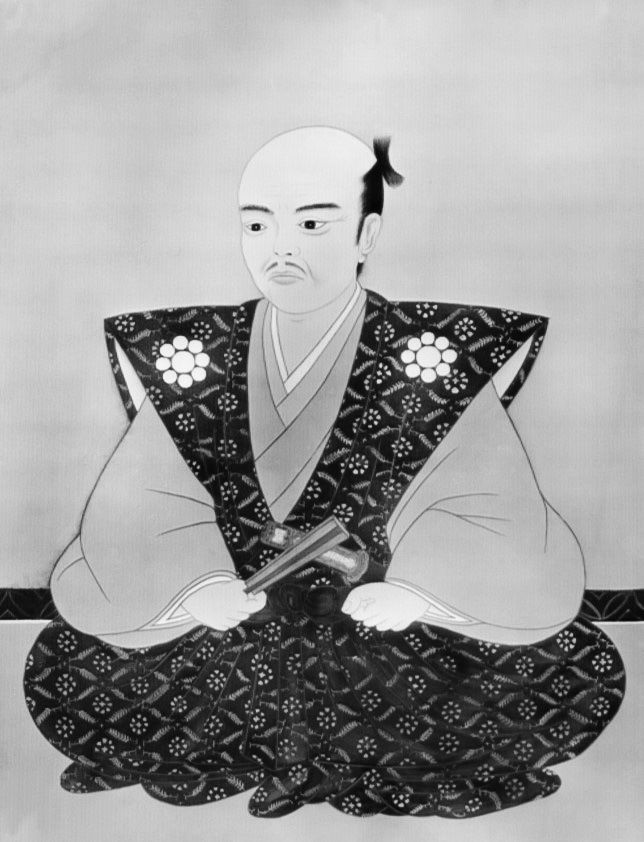
A portrait of Ishida Mitsunari. After defeat at the Battle of Sekigahara in 1600, Mitsunari was executed in Kyoto. In January 1978, his descendant Ishida Takayuki re-created an accurate image of his face based on the skull recovered from his grave. (© Kyōdō)
Ieyasu’s Rise
With the death of Toshiie and the withdrawal of Mitsunari, Ieyasu’s power spiked within the government. Just three days after Mitsunari went to Sawayama Castle, Ieyasu moved from his residence at Mukaijima in Fushimi to the nishinomaru (western compound) in Osaka Castle. This sparked rumors among court nobles and priests that Ieyasu was now the ruler of Japan.
However, a planned attempt on Ieyasu’s life in late 1599 threw cold water on his ambitions. Maeda Toshinaga and Asano Nagamasa were among the plotters, although the exact details are unclear. Ieyasu’s suspicions led him to contemplate a military conquest of Toshinaga’s Kaga domain (now Ishikawa Prefecture).
Rattled, Toshinaga sent his mother to Ieyasu’s Edo (today Tokyo) as a hostage, while Nagamasa made his son the head of his family and retired to Fuchū in the province of Musashino (now Tokyo), ruled by the Tokugawas. Around this time, Katō Kiyomasa, Hosokawa Tadaoki, and others pledged loyalty to Ieyasu.
In early 1600, at the time of the New Year according to the traditional calendar, daimyō who came to pay greetings to Hideyori in the honmaru or main compound of Osaka Castle also went to do so to Ieyasu in the western compound. The next month, a letter with details of new territories for daimyō went out in Ieyasu’s name alone. He was now acting like the nation’s ruler .
The Naoe Letter
Before achieving total control, however, Ieyasu would have to win the Battle of Sekigahara later in the autumn of 1600. Events in the ensuing months set the stage for that decisive event.
Ieyasu next summoned Uesugi Kagekatsu of Aizu domain (now Fukushima Prefecture) to Osaka. Kagekatsu, the adopted son of powerful leader Uesugi Kenshin, had taken control of the clan after Kenshin’s death. Shortly before Hideyoshi died, Kagekatsu was transferred from Echigo province (now Niigata Prefecture) to a much larger domain in Aizu.
When Hori Hideharu, himself based in Echigo, reported that he believed Kagekatsu was planning treason, Ieyasu called on Kagekatsu to come to Osaka. Busy strengthening his new territory, Kagekatsu did not respond. Ieyasu then sent a letter asking him to provide a written oath swearing his loyalty and travel immediately to Osaka.
Kagekatsu’s senior retainer Naoe Kanetsugu wrote a reply that has come to be known as the Naoe letter, attacking Hori Hideharu, explaining the Uesugi position, and even criticizing Ieyasu.
This letter and its refusal to go to Osaka induced Ieyasu to take up arms in a military campaign against Aizu. However, only copies exist, and so there have been disputes about its authenticity for centuries that continue today, with some maintaining that these are forgeries or embellished versions of a real original.
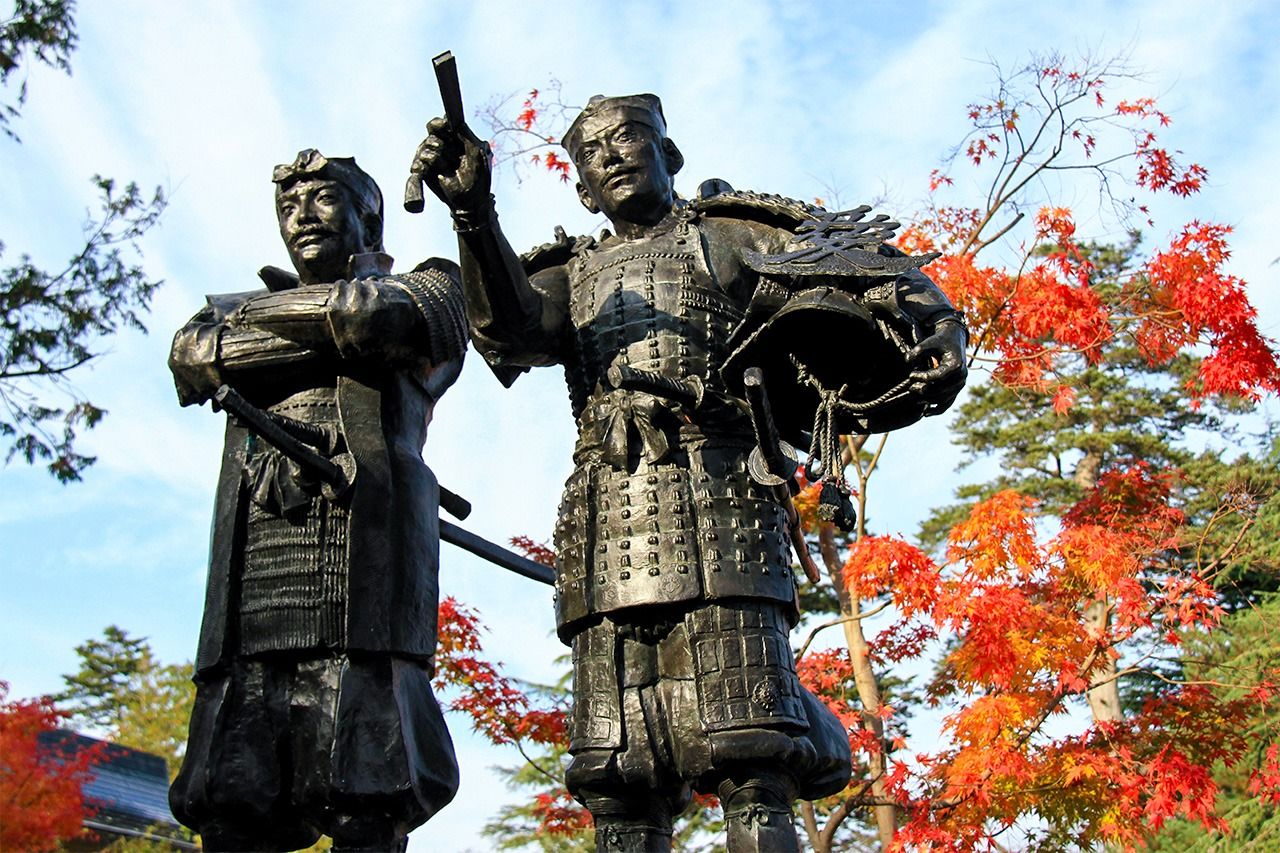
Statues of Uesugi Kagekatsu (left) and Naoe Kanetsugu at the ruins of Yonezawa Castle in Matsugamisaki Park, Yonezawa, Yamagata Prefecture. (© Pixta)
Choosing Sides
Ieyasu took the response from the Uesugi clan as rebellion against the Toyotomi government, and in July 1600, he set out with a huge army of 56,000 soldiers—although there is some debate as to this force’s actual size—from Osaka to Aizu. He had previously sent Mogami Yoshiaki and Date Masamune back to their domains, which bordered Kagekatsu’s territory.
It was said that Ieyasu gathered allies for this military expedition without regard to the established system of government. While some researchers still believe this, many view it as an official act of the Toyotomi government, as Ieyasu received permission from Hideyori, as well as overall authority, including military command.
Between Edo and Aizu, Ieyasu heard in Oyama (in what is now Tochigi Prefecture) that Mitsunari was raising an army in the west. The next day, on September 2, he held a famous meeting in which he told the assembled leaders it was time to choose their side. Silence followed as many had loved ones as hostages in Osaka Castle, and there was no guarantee that Ieyasu would win.
While there have been recent theories that this meeting did not take place at all, or that Fukushima Masanori was not in Oyama, the standard tale says that Fukushima was the first to pledge himself to the Tokugawa side, and others followed in their turn. The army turned around to head west again for the battle that would shape the future of Japan.
See the second and third parts of this three-part series: “The Battle of Sekigahara: A Fight for the Future of Japan” and “After Sekigahara: Reshaping Japan.”
(Originally published in Japanese on October 26, 2023. Banner photo: The view from Sasaoyama where Ishida Mitsunari’s army looked down on Tokugawa Ieyasu’s troops in Sekigahara, Gifu Prefecture. © Jiji.)
history Toyotomi Hideyoshi Tokugawa Ieyasu Battle of Sekigahara Ishida Mitsunari